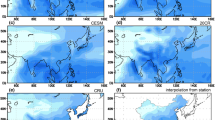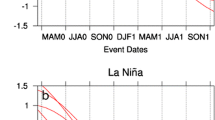Abstract
Variability and associated mechanisms of summer rainfall over east China are identified and described using both observations and a general circulation model (GCM) simulation. The observations include two data sets: the 90-station, 1470–1988 annual drought/flood index and the 60-station, 1889–1988 monthly mean precipitation measurements. The GCM data set is a 100-year equilibrium simulation of the present climate. Spectra of the drought/flood index indicate decadal cycles which decrease from north (≈47 y) to south (≈21 y). Correlation coefficients show decadal variability in the relationship between index values along the Yangtse River valley and those over northeast and southeast China. Analysis of the measured data confirms this result; for example, the correlation was small during 1889–1918, but significantly negative during 1930–1959. When compared with precipitation measurements, the GCM better simulates monthly means and variances along the Yangtse River valley. Three distinct 30-year periods of interannual variability in summer rainfall are found over this area. During each period, rainfall is negatively correlated with spring surface temperature over a remote region and is identified with variations in a specific component of the east Asian monsoon circulation: (1) when Eurasian temperatures decrease, the thermal contrast across the Mei-Yu front increases and frontal rainfall intensities; (2) lower temperatures over the Sea of Japan/northwest Pacific Ocean are identified with enhanced easterly flow, moisture transport and rainfall; (3) when tropical east Pacific Ocean temperatures decrease, rainfall associated with the low latitude monsoon trough increases. Given that the GCM generates decadal changes in the relationship between the physical mechanisms, the east Asian monsoon and planetary general circulations and east China rainfall, future studies should focus on the predictability of these changes with the use of improved and much longer GCM simulations.
Similar content being viewed by others
References
Barnett PT, Dümenil L, Schlese U, Roeckner E, Latif M (1989) The effect of Eurasian snow cover on regional and global climate variations. J Atmos Sci 46:661–685
CAMS (1981) Yearly charts of dryness/wetness China for the last 500-year period. In: Chinese Academy of Meteorological Sciences (ed) Atlas Press, Beijing (in Chinese)
Cohen J, Rind D (1991) The effect of snow cover on the climate. J Clim 4:689–706
Covey C, Thompson SL (1989) Testing the effects of ocean heat transport on climate. Palaeogeogr Paleoclimatol Paleoecol 75:331–341
Elliott WP, Angell JK (1987) The relation between Indian monsoon rainfall, the Southern Oscillation, and hemispheric air and sea temperature 1884–1984. J Climate Appl Meteorol 26:934–948
Elliott WP, Angell JK (1988) Evidence for changes in Southern Oscillation relationships during the last 100 years. J Clim 1:729–737
Fu CB, Fletcher J (1985) The relationship between Tibet-tropical ocean thermal contrast and interannual variability of Indian monsoon rainfall. J Climatol Appl Meteorol 24:841–847
Fu CB, Fletcher J (1988) Large signals of climatic variations over the ocean in the Asian monsoon region. Adv Atmos Sci 5:389–404
Fu CB, Teng XL (1988) The relationship between summer climate anomalies in China and El Niño-Southern Oscillation phenomena. Sci Atmos Sinica (Spec Iss):133–141
Jaeger L (1976) Monatskarten des Niederschlags für die ganze Erde. Ber Dtsch Wetterdienstes 18 (239)
Khandekar ML (1991) Eurasian snow cover, Indian monsoon and El Niño/Southern Oscillation — a synthesis. Atmos-Ocean 29:636–647
Kutzbach JE (1987) The changing pulse of the monsoon. In: Fein JS, Stephens PL (eds) Monsoons. John Wiley, New York, pp 247–268
Liang X-Z, Wang W-C, Dudek MP (1994). Interannual variability of regional climate and its change due to the greenhouse effect. MECCA Spec Iss Global Planet Change (accepted)
Mooley DA, Shukla J (1987) Variability and forecasting of the summer monsoon rainfall over India. In: Chang C-P, Krishnamurti TN (eds) Monsoon meteorology. Oxford University Press, Oxford, pp 26–59
Parthasarathy B, Rupa Kumar K, Munot AA (1991) Evidence of secular variations in Indian monsoon rainfall-circulation relationships. J Clim 4:927–938
Ronberg B, Wang W-C (1987) Climate patterns derived from Chinese proxy precipitation records: an evaluation of the station networks and statistical techniques. J Climatol 7:391–416
Shukla J (1987) Interannual variability of monsoons. In: Fein JS, Stephens PL (eds) Monsoons. John Wiley, New York, pp 399–463
Tao S, Chen L (1987) A review of recent research on the east Asian summer monsoon in China. In: Chang C-P, Krishnamurti TN (eds) Monsoon meteorology. Oxford University Press, Oxford, pp 60–92
Tao S, Fu C, Zeng Z, Zhang Q-Y (1991) Two long-term instrumental climate data bases of the People's Republic of China. In: Kaiser DP (ed) Environmental Sciences Division, DOE, Publication No. 3747, ORNL/CDIAC-47, NDP-039
Wang W-C, Shi G-Y, Kiehl JT (1991) Incorporation of the thermal radiative effect of CH4, N2O, CF2Cl2, and CFCl3 into the National Center for Atmospheric Research Community Climate Model. J Geophys Res 96:9097–9103
Wang W-C, Dudek MP, Liang X-Z (1992) Inadequacy of effective CO2 as a proxy in assessing the regional climate change due to other radiatively active gases. Geophys Res Lett 19:1375–1678
Williamson DL, Kiehl JT, Ramanathan V, Dickenson RE, Hack JJ (1987) Description of NCAR Community Climate Model (CCM1). NCAR Tech Note, NCAR/TN-285+STR
Xu Q (1975) Mei-Yu (monsoon rainfall) in the Yangtse River valley during the last 80 years. Acta Meteorol Sinica 33:507–518
Yasunari T, Kitoh A, Tokioka T (1991) Local and remote responses to excessive snow mass over Eurasia appearing in the Northern spring and summer climate, a study with the MRI GCM. J Meteorol Soc Japan 69:473–487
Zwiers F (1993) Simulation of the Asian summer monsoon with the CCC GCM-1. J Clim 6:470–486
Author information
Authors and Affiliations
Rights and permissions
About this article
Cite this article
Liang, XZ., Samel, A.N. & Wang, WC. Observed and GCM simulated decadal variability of monsoon rainfall in east China. Climate Dynamics 11, 103–114 (1995). https://doi.org/10.1007/BF00211676
Received:
Accepted:
Issue Date:
DOI: https://doi.org/10.1007/BF00211676




